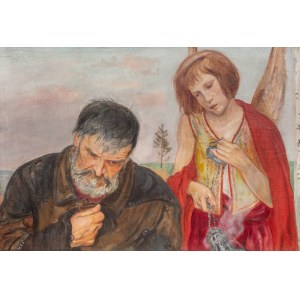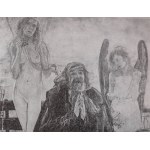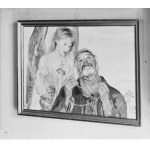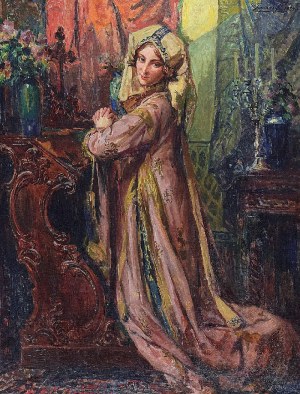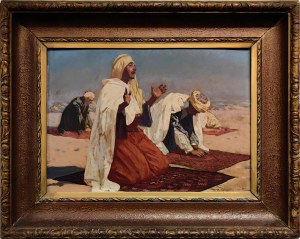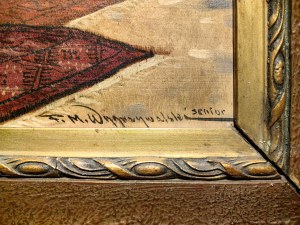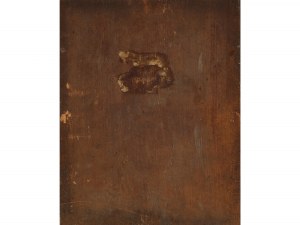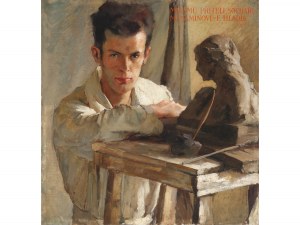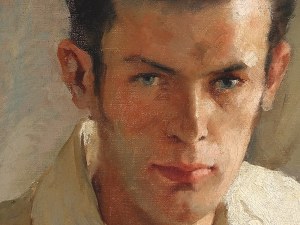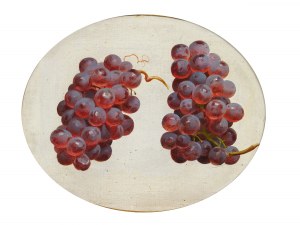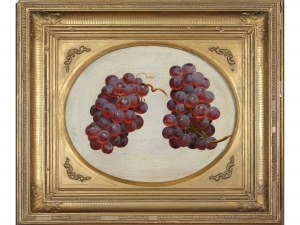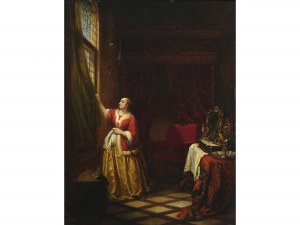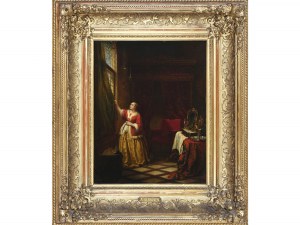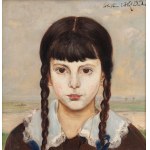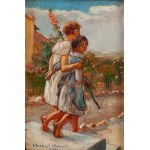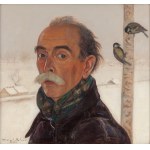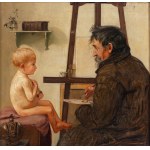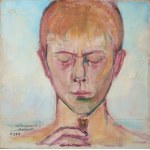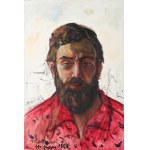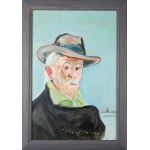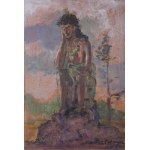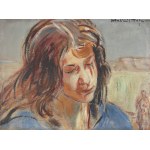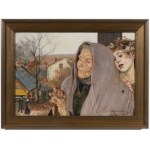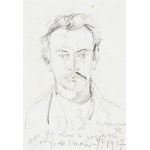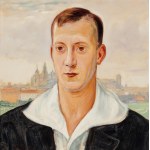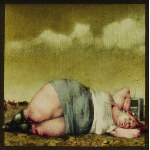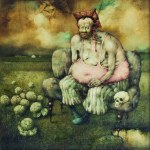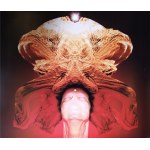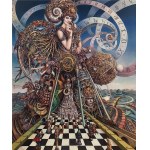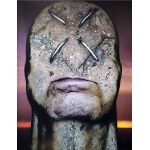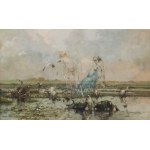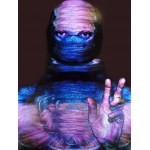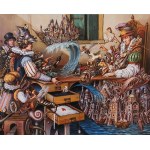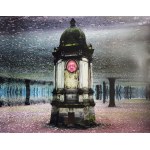oil, canvas, 68.5 x 100 cm
Signed and dated l.d.: Wlastimil Hofman / 1924
"My art develops around prayer, around the contact of the human spirit with God (...) the prayer of the spirit and the body are the highest human manifestations, the most worthy to be represented in art."
Wlastimil Hofman
Memoir, July 27, 1915
The statement that Wlastimil Hofman's work focused on religious painting is as valid as possible, but general and, so to speak, superficially treating the artist's output. Key to its understanding are the words of the artist himself, who stated that he was "a painter of thoughts and experiences"
(B. Czajkowski, Portrait from Memory, Wroclaw 1971, p. 137). Hofman symbolically depicts the emotional sphere of his models, simple and life-experienced people, whom he perceives as sincere and authentic. Above all, however, the artist's paintings should be read as a kind of painterly autobiography, in which, as in a mirror, the painter's sensitive and ardent spirit and intellect are reflected. Hofman leaves us no doubt about this, as confirmed by a note made by the artist in Szklarska Poreba on September 19, 1956 (quoted in Wlastimil Hofman. Autobiography, Warsaw 2020, p. 9):
"You will find my entire past in my paintings
Given strictly in the most faithful manner,
In virtuous beauty and sinful blemishes ,
Even and detail of life's finest"
Hofman was a deeply spiritual man, and his religiosity took a turn for the better especially after he returned to the country after emigrating during World War II. The spiritual element in the painter's work resounded already in his early works and accompanied him throughout his later life. He was baptized by Stanislaw Przybyszewski as "the Polish Fra Angelico" (Collective exhibition of W. Hofmann's works in Prague, "Fine Arts" 1924-1925, No. 4, p. 193). The turning point was certainly the realization of the painting titled "Confession" (1906), now in the
in the collection of the National Museum in Warsaw. The artist was faithful to the direction once chosen, flowing from personal experiences and convictions: "The road to the highest goal in art leads through a constant and ever-deepening reaching out to one's own self, and thus to not to abandon this path under any pretense, even if the whole world conspires against us. I believe that everything that is done without conviction - for the sake of so-called fashion, must sooner or later collapse, because this is the order of things."
(B. Tchaikovsky, op. cit., p. 139). A few years later he wrote down: "I have long understood that the higher the spirit, the heavier will be its cross, and that this cross is salvation. Every creator only through purifying suffering elevates his creation with God's help. There is no other way. Slothfulness of spirit is here on earth the greatest sin" (Szklarska Poreba, 7 II 1951, quoted in Wlastimil Hofman..., op. cit. p. 26). As if to confirm these deeply held beliefs, the artist created almost continuously, even while already ailing, and filled his canvases with Madonnas, angels, saints, images of praying old people and children. He poignantly portrayed melancholy reverie, ardent hearts, juxtaposed Old Age with Youth, and touched on themes relating to eschatological issues. These realizations differ from typical religious representations dedicated to temples. Iconographically, they are often limited to a single attribute, a symbol, the rest is completed in the eyes of the viewer, the narrative takes place in secular costume.
In the offered painting, Hofman used a motif and compositional arrangement to which he often returned - with the figure of an old man immersed in penitent prayer, assisted by an angel with the features of a child. The girl posing for the artist as a heavenly guardian also appears in a realization created a year earlier and compositionally expanded with an additional female figure - cf: "Old Age", 1923, oil, plywood, 110 x 150 cm, signed and dated l. d.: "Vlastimil Hofman 1923", collection of the Museum of Central Pomerania in Slupsk, inv. no. MPS-M/23. There she also holds in her hands an incense stick, which symbolizes cleansing from sins and prayer ascending to heaven ("Let my prayer rise toward you like incense" - Psalm 141:2). Casting a child in the role of an angel is no accident, the artist explained in detail: "I like children very much - and that's why I like to paint them, but that's not all (...) With the mouth of a child speaks truth, beauty and goodness - it's the nature of a child, and at the same time every child - it's a mirror of death, that death you can so often encounter in my paintings. (...) There are no masks on their faces, and yet the human face is the basic material in most of my compositions." (B. Czajkowski, op. cit., p. 138). Thus, the child appears here as a guide still untainted by sin, revealing the truth at the last turn on the path of life. The figure of the old man is also one of his favorite motifs taken up with his brush on canvas: "...I like to paint people who live outside the mainstream of life. For example, homeless old people, beggars, vagrants. People without today and tomorrow. They know life better, they have less to lose. They do what they want.
They are more natural, more authentic, and most importantly, they are independent. And that's why they interest me more." (Ibid.). The thing that is formally characteristic of Hofman's paintings is the somewhat photographic way of framing the picture, in which the silhouettes, framed in a half pose, fill a significant area of the canvas
and seem to almost "come out" of the frames, while the landscape parts are reduced to a minimum. The key is the subject itself, the narrative of the representation.
The presented work comes from the best, pre-war period in Hofman's work. It fully realizes the assumptions that the painter made and to which he remained faithful. It delights in terms of drawing, color sense and shows the artist as an excellent observer who skillfully captures the psychological nature of the figures, who is in fact "a painter of thoughts and experiences."
Fig.1. Wlastimil Hofman, "Old Age", 1923, collection of the Museum of Central Pomerania in Slupsk, source - Works or kitsch, ed. E. Grabska, T. S. Jaroszewski, Warsaw 1981, p. 415
Fig. 2. Hofman's painting presented during an exhibition at the Cracow Artists' House in 1925, source - NAC (fragment), ref. 310113226, [accessed 22.12.2022].
Recently viewed
Please log in to see lots list
Favourites
Please log in to see lots list



